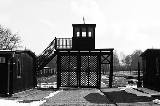
Stutthof concentration camp
Encyclopedia
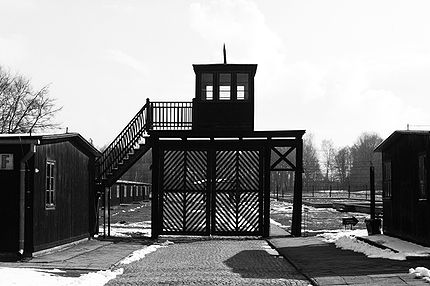
Nazi concentration camps
Nazi Germany maintained concentration camps throughout the territories it controlled. The first Nazi concentration camps set up in Germany were greatly expanded after the Reichstag fire of 1933, and were intended to hold political prisoners and opponents of the regime...
built outside of 1937 German borders.
Completed on September 2, 1939, it was located in a secluded, wet, and wooded area west of the small town of Sztutowo
Sztutowo
Sztutowo is a village in Nowy Dwór Gdański County, part of the Pomeranian Voivodeship of Poland. It is located about 38 km east of Gdańsk on the northeastern edge of the Vistula Delta, at the base of the Vistula Spit on the Baltic coast....
. The town is located in the former territory of the Free City of Danzig
Free City of Danzig
The Free City of Danzig was a semi-autonomous city-state that existed between 1920 and 1939, consisting of the Baltic Sea port of Danzig and surrounding areas....
, 34 km east of Gdańsk
Gdansk
Gdańsk is a Polish city on the Baltic coast, at the centre of the country's fourth-largest metropolitan area.The city lies on the southern edge of Gdańsk Bay , in a conurbation with the city of Gdynia, spa town of Sopot, and suburban communities, which together form a metropolitan area called the...
, Poland. Stutthof was the last camp liberated by the Allies
Allies of World War II
The Allies of World War II were the countries that opposed the Axis powers during the Second World War . Former Axis states contributing to the Allied victory are not considered Allied states...
, on May 9, 1945. More than 85,000 victims died in the camp out of as many as 110,000 people deported there.
Camp
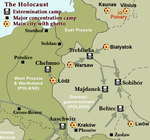
Free City of Danzig
The Free City of Danzig was a semi-autonomous city-state that existed between 1920 and 1939, consisting of the Baltic Sea port of Danzig and surrounding areas....
were compiling material about known Jews and Polish intelligentsia as early as 1936 and were also reviewing suitable places to build concentration camps in their area. Originally, Stutthof was a civilian internment camp under the Danzig police chief. In November 1941, it became a "labor education" camp, administered by the German Security Police
Sicherheitsdienst
Sicherheitsdienst , full title Sicherheitsdienst des Reichsführers-SS, or SD, was the intelligence agency of the SS and the Nazi Party in Nazi Germany. The organization was the first Nazi Party intelligence organization to be established and was often considered a "sister organization" with the...
. Finally, in January 1942, Stutthof became a regular concentration camp.
The original camp (known as the old camp) was surrounded by barbed-wire fence. It comprised eight barracks for the inmates and a "kommandantur" for the SS
Schutzstaffel
The Schutzstaffel |Sig runes]]) was a major paramilitary organization under Adolf Hitler and the Nazi Party. Built upon the Nazi ideology, the SS under Heinrich Himmler's command was responsible for many of the crimes against humanity during World War II...
guards, totalling 120,000 m². In 1943, the camp was enlarged and a new camp was constructed alongside the earlier one. It was also surrounded by electrified barbed-wire fence and contained thirty new barracks, raising the total area to 1.2 km².
The camp staff consisted of SS guards and after 1943, Ukrainian auxiliaries. In 1942 the first female prisoners and female German guards arrived in Stutthof, including Aufseherin Herta Bothe
Herta Bothe
Herta Bothe was a female Nazi concentration camp guard imprisoned for war crimes, but eventually released.-Early life:Herta Bothe was born in Teterow. In 1938 Bothe helped her father in his small Teterow wood shop, then worked temporarily in a factory, then as a nurse in the hospital industry...
. A total of over 130 women served in the Stutthof complex of camps. 34 female guards, including Gerda Steinhoff
Gerda Steinhoff
Gerda Steinhoff born in Danzig-Langfuhr , was a Nazi concentration camp overseer following the 1939 German invasion of Poland.-SS career:...
, Rosy Suess, Ewa Paradies
Ewa Paradies
Ewa Paradies was a Nazi concentration camp overseer.Paradies was born in Lauenburg, Pomerania , Neuendorferstrasse 100. She was a Protestant Christian and not married. In 1935 she left school and worked various jobs in Wuppertal, Erfurt and Lauenburg.In August 1944 she went to Stutthof SK-III camp...
and Jenny-Wanda Barkmann
Jenny-Wanda Barkmann
Jenny-Wanda Barkmann was a Nazi concentration camp guard.She is believed to have spent her childhood in Hamburg, Germany. In 1944, she became an Aufseherin in the Stutthof SK-III women's camp, where she brutalized prisoners, some to death. She also selected women and children for the gas chambers...
, have been identified later as having committed crimes against humanity at Stutthof. Starting in June 1944, the SS in Stutthof began conscripting women from Danzig and the surrounding cities to train as camp female guards because of a severe shortage of guards. In 1944 a women's subcamp of Stutthof called Bromberg-Ost
Bromberg-Ost
Bromberg-Ost or Konzentrationslager Bromberg-Ost , was the female subcamp of the German concentration camp Stutthof between 1944-1945, in the city of Bydgoszcz....
(Konzentrationslager Bromberg-Ost) was set up in the city of Bydgoszcz.
A crematorium and gas chamber were added in 1943, just in time to start mass executions when Stutthof was included in the "Final Solution
Final Solution
The Final Solution was Nazi Germany's plan and execution of the systematic genocide of European Jews during World War II, resulting in the most deadly phase of the Holocaust...
" in June 1944. Mobile gas wagons were also used to complement the maximum capacity of the gas chamber (150 people per execution) when needed.
Prisoners
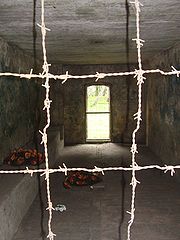
Tens of thousands of people, perhaps as many as 110,000, were deported to the Stutthof camp. The prisoners were mainly non-Jewish Poles
Poles
thumb|right|180px|The state flag of [[Poland]] as used by Polish government and diplomatic authoritiesThe Polish people, or Poles , are a nation indigenous to Poland. They are united by the Polish language, which belongs to the historical Lechitic subgroup of West Slavic languages of Central Europe...
. There were also Polish Jews from Warsaw
Warsaw
Warsaw is the capital and largest city of Poland. It is located on the Vistula River, roughly from the Baltic Sea and from the Carpathian Mountains. Its population in 2010 was estimated at 1,716,855 residents with a greater metropolitan area of 2,631,902 residents, making Warsaw the 10th most...
and Białystok, and Jews from forced-labour camps in the occupied Baltic states
Baltic states
The term Baltic states refers to the Baltic territories which gained independence from the Russian Empire in the wake of World War I: primarily the contiguous trio of Estonia, Latvia, Lithuania ; Finland also fell within the scope of the term after initially gaining independence in the 1920s.The...
, which the Germans evacuated in 1944 as Soviet forces approached. These totals are thought to be conservative, as it is believed that inmates sent for immediate execution were not registered.A number of German was also sent to the camp, where they were known as "camp aristocracy"-a large group of German criminals was also given kapo
Kapo
Kapo can refer to one of the following:* Kapo , a Hawaiian goddess or god* Kapo , a privileged prisoner who served as a barracks supervisor/warder or led work details in a Nazi concentration camp...
positions and terrorized other inmates, other Germans included a couple of socialdemocrats , and later members of military faction that tried to gain power from Hitler; in 1945 the camp authorities noted that 35% of inmates are Poles, 8% Russians, and 7% Germans(some of which were Poles who refused to accept Volksliste)
When the Soviet army
Red Army
The Workers' and Peasants' Red Army started out as the Soviet Union's revolutionary communist combat groups during the Russian Civil War of 1918-1922. It grew into the national army of the Soviet Union. By the 1930s the Red Army was among the largest armies in history.The "Red Army" name refers to...
began its advance through Nazi-occupied Estonia
Estonia
Estonia , officially the Republic of Estonia , is a state in the Baltic region of Northern Europe. It is bordered to the north by the Gulf of Finland, to the west by the Baltic Sea, to the south by Latvia , and to the east by Lake Peipsi and the Russian Federation . Across the Baltic Sea lies...
in July and August 1944, the camp staff of Klooga concentration camp
Klooga concentration camp
Klooga was a Nazi labor subcamp of the Vaivara concentration camp complex established in September 1943 in Harju County, during World War II, in German-occupied Estonia near the northern Estonian village Klooga...
evacuated the majority of the inmates by sea to the Stutthof concentration camp.
Conditions
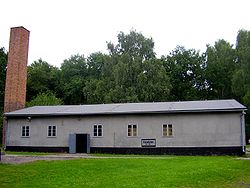
Typhus
Epidemic typhus is a form of typhus so named because the disease often causes epidemics following wars and natural disasters...
epidemics that swept the camp in the winter of 1942 and again in 1944. Those whom the SS guards judged too weak or sick to work were gassed in the camp's small gas chamber. Gassing with Zyklon B
Zyklon B
Zyklon B was the trade name of a cyanide-based pesticide infamous for its use by Nazi Germany to kill human beings in gas chambers of extermination camps during the Holocaust. The "B" designation indicates one of two types of Zyklon...
began in June 1944. Camp doctors also killed sick or injured prisoners in the infirmary with lethal injections. More than 85,000 people died in the camp.
The Germans used Stutthof prisoners as forced labourers. Some prisoners worked in SS-owned businesses such as the German Equipment Works (DAW), located near the camp. Others laboured in local brickyards, in private industrial enterprises, in agriculture, or in the camp's own workshops. In 1944, as forced labour by concentration camp prisoners became increasingly important in armaments production, a Focke-Wulf
Focke-Wulf
Focke-Wulf Flugzeugbau AG was a German manufacturer of civil and military aircraft before and during World War II. Many of the company's successful fighter aircraft designs were slight modifications of the Focke-Wulf Fw 190.-History:...
aircraft factory was constructed at Stutthof. Eventually, the Stutthof camp system became a vast network of forced-labour camps; 105 Stutthof subcamps were established throughout northern and central Poland. The major subcamps were Thorn
Torun
Toruń is an ancient city in northern Poland, on the Vistula River. Its population is more than 205,934 as of June 2009. Toruń is one of the oldest cities in Poland. The medieval old town of Toruń is the birthplace of the astronomer Nicolaus Copernicus....
and Elbing
Elblag
Elbląg is a city in northern Poland with 127,892 inhabitants . It is the capital of Elbląg County and has been assigned to the Warmian-Masurian Voivodeship since 1999. Before then it was the capital of Elbląg Voivodeship and a county seat in Gdańsk Voivodeship...
.
The Stutthof camp has been suggested as one of the possible sources for human remains that Dr. Rudolf Spanner
Rudolf Spanner
Rudolf Spanner was Director of the Danzig Anatomical Institute during World War II. On his own initiative, he set up a process to produce soap from human fat in 1943-44 and a limited quantity of the soap was produced on his order to clean autopsy rooms.In his book "Russia at War 1941 to 1945",...
used to make a limited quantity of soap from human fat
Soap made from human corpses
In the 20th century, there have been various alleged instances of soap being made from human body fat. During World War II it was believed that soap was being mass produced from the bodies of Polish and Jewish concentration camp victims....
.
The former prisoner of Stutthoff and Lithuania
Lithuania
Lithuania , officially the Republic of Lithuania is a country in Northern Europe, the biggest of the three Baltic states. It is situated along the southeastern shore of the Baltic Sea, whereby to the west lie Sweden and Denmark...
n writer Balys Sruoga
Balys Sruoga
Balys Sruoga was a Lithuanian poet, playwright, critic, and literary theorist.He contributed to cultural journals from his early youth...
later wrote a novel Dievų miškas (The Forest of Gods) describing the everyday life of this camp.
Soap production from the bodies of victims
Some evidence exists of small-scale soap production of soap made from human corpsesSoap made from human corpses
In the 20th century, there have been various alleged instances of soap being made from human body fat. During World War II it was believed that soap was being mass produced from the bodies of Polish and Jewish concentration camp victims....
in the Stutthof concentration camp.
In his book "Russia at War 1941 to 1945", Alexander Werth
Alexander Werth
Alexander Werth was a Russian-born, naturalized British writer, journalist, and war correspondent.-Biography:Werth's family fled to the United Kingdom in the wake of the Russian Revolution....
reported that while visiting Gdańsk/Danzig in 1945 shortly after its liberation by the Red Army, he saw an experimental factory outside the city for making soap from human corpses. According to Werth it had been run by "a German professor called Spanner" and "was a nightmarish sight, with its vats full of human heads and torsoes pickled in some liquid, and its pails full of a flakey substance - human soap".
Death march
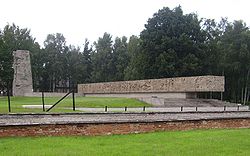
Baltic Sea
The Baltic Sea is a brackish mediterranean sea located in Northern Europe, from 53°N to 66°N latitude and from 20°E to 26°E longitude. It is bounded by the Scandinavian Peninsula, the mainland of Europe, and the Danish islands. It drains into the Kattegat by way of the Øresund, the Great Belt and...
coast, forced into the water, and machinegunned. The rest of the prisoners were marched in the direction of Lauenburg
Lebork
Lębork is a town on the Łeba and Okalica rivers in Middle Pomerania region, north-western Poland with some 37,000 inhabitants.Lębork is also the capital of Lębork County in Pomeranian Voivodeship since 1999, formerly in Słupsk Voivodeship ....
in eastern Germany. They were cut off by advancing Soviet forces. The Germans forced the surviving prisoners back to Stutthof. Marching in severe winter conditions and treated brutally by SS guards, thousands died during the march.
In late April 1945, the remaining prisoners were removed from Stutthof by sea, since Stutthof was completely encircled by Soviet forces. Again, hundreds of prisoners were forced into the sea and shot. Over 4,000 were sent by small boat to Germany, some to the Neuengamme concentration camp near Hamburg
Hamburg
-History:The first historic name for the city was, according to Claudius Ptolemy's reports, Treva.But the city takes its modern name, Hamburg, from the first permanent building on the site, a castle whose construction was ordered by the Emperor Charlemagne in AD 808...
, and some to camps along the Baltic coast. Many drowned along the way. A barge full of prisoners was washed ashore at Klintholm Havn
Klintholm Havn
Klintholm Havn is a fishing village and a popular tourist resort on the south coast of Møn, an island in Vordingborg Municipality, southeastern Denmark. As of 1 January 2010, the population is 209.The harbour was built in 1878 by C.S...
in Denmark where 351 of the 370 on board were saved on 5 May 1945. Shortly before the German surrender, some prisoners were transferred to Malmö
Malmö
Malmö , in the southernmost province of Scania, is the third most populous city in Sweden, after Stockholm and Gothenburg.Malmö is the seat of Malmö Municipality and the capital of Skåne County...
, Sweden, and released into the care of that neutral country. It has been estimated that over 25,000 prisoners, one in two, died during the evacuation from Stutthof and its subcamps.
Liberation
Soviet forces liberated Stutthof on May 9, 1945, and liberated about 100 prisoners who had managed to hide during the final evacuation of the camp.Stutthof sub camps
Sub-camps of the German concentration camp Stutthof near Danzig during the Third Reich:
|
Elbing Elbing is the German name of Elbląg, a city in northern Poland which until 1945 was a German city in the province of East Prussia.Elbing may also refer to:- Ships :* SMS Elbing, light cruiser of the Imperial Germany Navy... (Schichau-Werke Schichau-Werke The Schichau-Werke was a German engineering works and shipyard based in Elbing, formerly part of the German Empire, and which is today the town of Elbląg in northern Poland. It also had a subsidiary shipyard in Danzig .-Early years:... ) Police, Poland Police is a town in the West Pomeranian Voivodeship, northwestern Poland. It is the capital of Police County. As of 2006, the town had 34,284 inhabitants. The name comes from Polish pole, which means "field".... / Szczecin Szczecin Szczecin , is the capital city of the West Pomeranian Voivodeship in Poland. It is the country's seventh-largest city and the largest seaport in Poland on the Baltic Sea. As of June 2009 the population was 406,427.... Gdynia Gdynia is a city in the Pomeranian Voivodeship of Poland and an important seaport of Gdańsk Bay on the south coast of the Baltic Sea.Located in Kashubia in Eastern Pomerania, Gdynia is part of a conurbation with the spa town of Sopot, the city of Gdańsk and suburban communities, which together... Gutowo Gutowo may refer to:* Gutowo, a sub-camp of Stutthof concentration camp*Gutowo, Brodnica County in Kuyavian-Pomeranian Voivodeship *Gutowo, Toruń County in Kuyavian-Pomeranian Voivodeship... Heiligenbeil concentration camp Heiligenbeil was a subcamp of the German concentration camp Stutthof near Danzig. It was named after the East Prussian town Heiligenbeil .- External links :*... |
Kolkau Kolkau was a subcamp of the German concentration camp Stutthof near Danzig during the Third Reich.... Krzemieniewo Krzemieniewo may refer to the following places in Poland:*Krzemieniewo, Greater Poland Voivodeship *Krzemieniewo, Pomeranian Voivodeship *Krzemieniewo, Warmian-Masurian Voivodeship... Lebork Lębork is a town on the Łeba and Okalica rivers in Middle Pomerania region, north-western Poland with some 37,000 inhabitants.Lębork is also the capital of Lębork County in Pomeranian Voivodeship since 1999, formerly in Słupsk Voivodeship .... Malken Mierzynek Malken Mierzynek was a subcamp of the German concentration camp Stutthof near Danzig during the Third Reich.... Nawitz Nawitz is the German name of Nawcz, and was a subcamp of the German Stutthof concentration camp near Danzig during the Third Reich.... Niskie Niskie was a subcamp of the German concentration camp Stutthof near Danzig during the Third Reich.... Obrzycko Obrzycko is a town in Szamotuły County, Greater Poland Voivodeship, Poland, with 2,172 inhabitants .Nearby municipalities include Wronki, Ostroróg, and Szamotuły.- Notable residents :* Abraham Berliner , historian... |
Rosenberg - Places :* Rosenberg, Baden, a municipality in the district of Neckar-Odenwald, Baden-Württemberg, Germany* Rosenberg , a municipality in the district of Ostalbkreis, Baden-Württemberg, Germany... / Brodnica Brodnica Brodnica is a town in northern Poland with 27,400 inhabitants . Previously part of Toruń Voivodeship [a province], from 1975 to 1998, Brodnica has been situated in the Kuyavian-Pomeranian Voivodeship since 1999... Pruszcz Pruszcz may refer to the following places:*Pruszcz, Świecie County in Kuyavian-Pomeranian Voivodeship *Pruszcz, Tuchola County in Kuyavian-Pomeranian Voivodeship... Brusy Brusy is a town located in the Polish Pomeranian Voivodeship. In the 19th century it was an important centre of the Kashub movement.Brusy became a town in 1988.... Torun Toruń is an ancient city in northern Poland, on the Vistula River. Its population is more than 205,934 as of June 2009. Toruń is one of the oldest cities in Poland. The medieval old town of Toruń is the birthplace of the astronomer Nicolaus Copernicus.... (AEG AEG Allgemeine Elektricitäts-Gesellschaft was a German producer of electrical equipment founded in 1883 by Emil Rathenau.... , Org. Todt) |
Commanders
- SS-SturmbannführerSturmbannführerSturmbannführer was a paramilitary rank of the Nazi Party equivalent to major, used both in the Sturmabteilung and the Schutzstaffel...
- Max PaulyMax PaulyMax Pauly was an SS Sturmbannführer who was the commandant of Stutthof concentration camp from September, 1939 to August 1942 and commandant of Neuengamme concentration camp and the associated subcamps from September 1942 until liberation in May 1945.During his tenure as commandant of Neuengamme...
- September 39 - August 42 - SS-SturmbannführerSturmbannführerSturmbannführer was a paramilitary rank of the Nazi Party equivalent to major, used both in the Sturmabteilung and the Schutzstaffel...
- Werner HoppeWerner Hoppe (SS-Officer)Paul Werner Hoppe was an SS Sturmbannführer and was the commandant of Stutthof concentration camp from September 1942 until April 1945....
- August 42 - January 45
Stutthof Trials
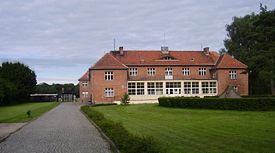

Nuremberg Trials
The Nuremberg Trials were a series of military tribunals, held by the victorious Allied forces of World War II, most notable for the prosecution of prominent members of the political, military, and economic leadership of the defeated Nazi Germany....
did not include staff of the Stutthof concentration camp. However, the Poles held four trials in Gdańsk
Gdansk
Gdańsk is a Polish city on the Baltic coast, at the centre of the country's fourth-largest metropolitan area.The city lies on the southern edge of Gdańsk Bay , in a conurbation with the city of Gdynia, spa town of Sopot, and suburban communities, which together form a metropolitan area called the...
against former guards and kapos
Kapo (concentration camp)
A kapo was a prisoner who worked inside German Nazi concentration camps during World War II in any of certain lower administrative positions. The official Nazi word was Funktionshäftling, or "prisoner functionary", but the Nazis commonly referred to them as kapos.- Etymology :The origin of "kapo"...
of Stutthof, charging them with crimes of war and crimes against humanity. The first trial was held against 30 ex-officials and kapos of the camp, from April 25, 1946, to May 31, 1946. The Soviet/Polish Special Criminal Court found all of them guilty of the charges. Eleven of them, including the former commander, Johann Pauls, were sentenced to death. The rest were sentenced to various terms of imprisonment.
Some of the sentences of the first trial:
- Johann Pauls: death sentence (executed on July 4, 1946)
- Gerda SteinhoffGerda SteinhoffGerda Steinhoff born in Danzig-Langfuhr , was a Nazi concentration camp overseer following the 1939 German invasion of Poland.-SS career:...
: death sentence (executed on July 4, 1946) - Kapo Josef Reiter: death sentence (executed on July 4, 1946)
- Wanda KlaffWanda KlaffWanda Klaff was a Nazi camp overseer.Klaff was born in Danzig to German parents as Wanda Kalacinski. She finished school in 1938 and began working in a jam factory. This lasted until 1942 when she married Willy Gapes and became a housewife.In 1944 Klaff joined the camp staff at the Stutthof's...
: death sentence (executed on July 4, 1946) - Erna Beilhardt: 5 years imprisonment
- Kapo Waclaw Kozlowski: death sentence (executed on July 4, 1946)
- Jenny-Wanda BarkmannJenny-Wanda BarkmannJenny-Wanda Barkmann was a Nazi concentration camp guard.She is believed to have spent her childhood in Hamburg, Germany. In 1944, she became an Aufseherin in the Stutthof SK-III women's camp, where she brutalized prisoners, some to death. She also selected women and children for the gas chambers...
: death sentence (executed on July 4, 1946) - Kapo Fanciszek Szopinski: death sentence (executed on July 4, 1946)
- Ewa ParadiesEwa ParadiesEwa Paradies was a Nazi concentration camp overseer.Paradies was born in Lauenburg, Pomerania , Neuendorferstrasse 100. She was a Protestant Christian and not married. In 1935 she left school and worked various jobs in Wuppertal, Erfurt and Lauenburg.In August 1944 she went to Stutthof SK-III camp...
: death sentence (executed on July 4, 1946) - Kapo Kazimierz Kowalski: 3 years imprisonment
- Jan Breit: death sentence (executed on July 4, 1946)
- Kapo Tadeusz Kopczynski: death sentence (executed on July 4, 1946)
- Elisabeth BeckerElisabeth BeckerElisabeth Becker was a concentration camp guard in World War II.-Life:Becker was born in Neuteich, Free City of Danzig to a German family. In 1936, aged 13, she joined the League of German Girls....
: death sentence (executed on July 4, 1946) - Werner Hoppe: Apprehended in 1953 in West Germany, later sentenced to 9 years imprisonment
The second trial was held from January 8, 1947, to January 31, 1947, before a Polish Special Criminal Court. 24 ex-officials and guards of the Stutthof concentration camp were judged and found guilty. Ten were sentenced to death.
The sentences of the second trial:
- Theodor Meyer: death sentence (executed on October 10, 1947)
- Ewald Foth: death sentence (executed on October 10, 1947)
- Karl Reger: 8 years imprisonment
- Eduard Zerlin: 12 years imprisonment
- Emil Wenzel: 10 years imprisonment
- Adalbert Wolter: 8 years imprisonment
- Karl Eggert: death sentence (executed on October 10, 1947)
- Wilhelm Vogler: 15 years imprisonment
- Paul Wellnitz: death sentence (executed on October 10, 1947)
- Kapo Alfred Nikolaysen: death sentence (executed on October 10, 1947)
- Hans Rach: death sentence (executed on October 10, 1947)
- Adolf Grams: 10 years imprisonment
- Josef Wennhardt: 8 years imprisonment
- Fritz Peters: death sentence (executed on October 10, 1947)
- Kurt Dietrich: death sentencee (executed on October 10, 1947)
- Hugo Ziehm: 3 years imprisonment
- Erich Thun: life imprisonment
- Albert Paulitz: death sentence (executed on October 10, 1947)
- Werner Wöllnitz: 10 years imprisonment
- Martin Stage: 8 years imprisonment
- Oskar Gottchau: 10 years imprisonment
- Karl Zurell: death sentence (executed on October 10, 1947)
- Walter Englert: 3 years imprisonment
- Johannes Görtz: 8 years imprisonment
The third trial was held from November 5, 1947, to November 10, 1947, before a Polish Special Criminal Court. 20 ex-officials and guards were judged. 19 were found guilty, and one was acquitted.
The sentences of the third trial:
- Karl Meinck: 12 years imprisonment
- Gustav Eberle: 10 years imprisonment
- Harry Müller: 4 years imprisonment
- Alfred Tissler: 5 years imprisonment
- Otto Schneider: 10 years imprisonment
- Johann Lichtner: 5 years imprisonment
- Ernst Thulke: 5 years imprisonment
- Otto Welke: 10 years imprisonment
- Willy Witt: 10 years imprisonment
- Heinz Löwen: 5 years imprisonment
- Erich Stampniok: 5 years imprisonment
- Richard Timm: 4 years imprisonment
- Adolf Klaffke: 10 years imprisonment
- Hans Möhrke: 4 years imprisonment
- Hans Tolksdorf: acquitted and released
- Nikolaus Dirnberger: 4 years imprisonment
- Friedrich Tessmer: 4 years imprisonment
- Erich Jassen: 10 years imprisonment
- Johann Sporer: 4 years imprisonment
- Nikolai Klawan: 3 years imprisonment
The fourth and final trial was also held before a Polish Special Criminal Court, from November 19, 1947, to November 29, 1947. 27 ex-officials and guards were judged, 26 were found guilty, and one was acquitted.
Sentences of the fourth trial:
- Christof Schwarz: 3 years imprisonment
- Albert Weckmüller: 15 years imprisonment
- Kurt Reduhn: 10 years imprisonment
- Walter Ringewald: 7 months imprisonment
- Hermann Link: 5 years imprisonment
- Richard Wohlfeil: 7 months imprisonment
- Waldemar Henke: 5 years imprisonment
- Anton Kniffke: 3 years imprisonment
- Kapo Franz Spillmann: acquitted and released
- Gustav Brodowski: 7 months imprisonment
- Johann Wrobel: 7 months imprisonment
- Ernst Knappert: 7 months imprisonment
- Martin Pentz: 5 years imprisonment
- Horst Köpke: 10 years imprisonment
- Bernard Eckermann: 7 months imprisonment
- Rudolf Berg: 10 years imprisonment
- Josef Stahl: 10 years imprisonment
- Johann Pfister: 5 years imprisonment
- Johannes Wall: 5 years imprisonment
- Leopold Baumgartner: 7 months imprisonment
- Willi Buth: life imprisonment
- Richard Akolt: 3 years imprisonment
- Fritz Glawe: 10 years imprisonment
- Emil Lascheit: 10 years imprisonment
- Gustav Kautz: 5 years imprisonment
- Emil Paul: 7 months imprisonment
- Erich Mertens: 5 years imprisonment
See also
- Stutthof TrialStutthof TrialStutthof Trial was a war crime tribunal held at Gdańsk, Poland, from April 25, 1946, to May 31, 1946, where the joint Soviet/Polish Special Criminal Court tried and convicted of crimes against humanity a group of thirteen ex-officials and overseers of the Stutthof concentration camp and...
- Nazi crimes against ethnic PolesNazi crimes against ethnic PolesIn addition to about 2.9 million Polish Jews , about 2.8 million non-Jewish Polish citizens perished during the course of the war...
- Soap made from human corpsesSoap made from human corpsesIn the 20th century, there have been various alleged instances of soap being made from human body fat. During World War II it was believed that soap was being mass produced from the bodies of Polish and Jewish concentration camp victims....
- List of Nazi-German concentration camps
- List of subcamps of Stutthof
- Rescue of Stutthof victims in DenmarkRescue of Stutthof victims in DenmarkThe rescue of Stutthof victims in Denmark took place on 5 May 1945 at Klintholm Havn, a small fishing village on the south coast of the island of Møn, when a barge full of famished Nazi concentration camp prisoners was towed into harbour....
External links
- Stutthof National Museum
- KL Stutthof monography
- SS personnel serving at Ravensbrück
- SS personnel serving at Stutthof
- Karl M. Haugan describes conditions at Stutthof (Norwegian)
- United States Holocaust Memorial Museum Encyclopedia entry
- Brief facts and photos of the camp (The accuracy of the statements in this link are dubious, for instance the allegation it makes regarding the meaning of R.J.F. is completely untrue. See the link below for further info.)
- "The Soap Allegations"

